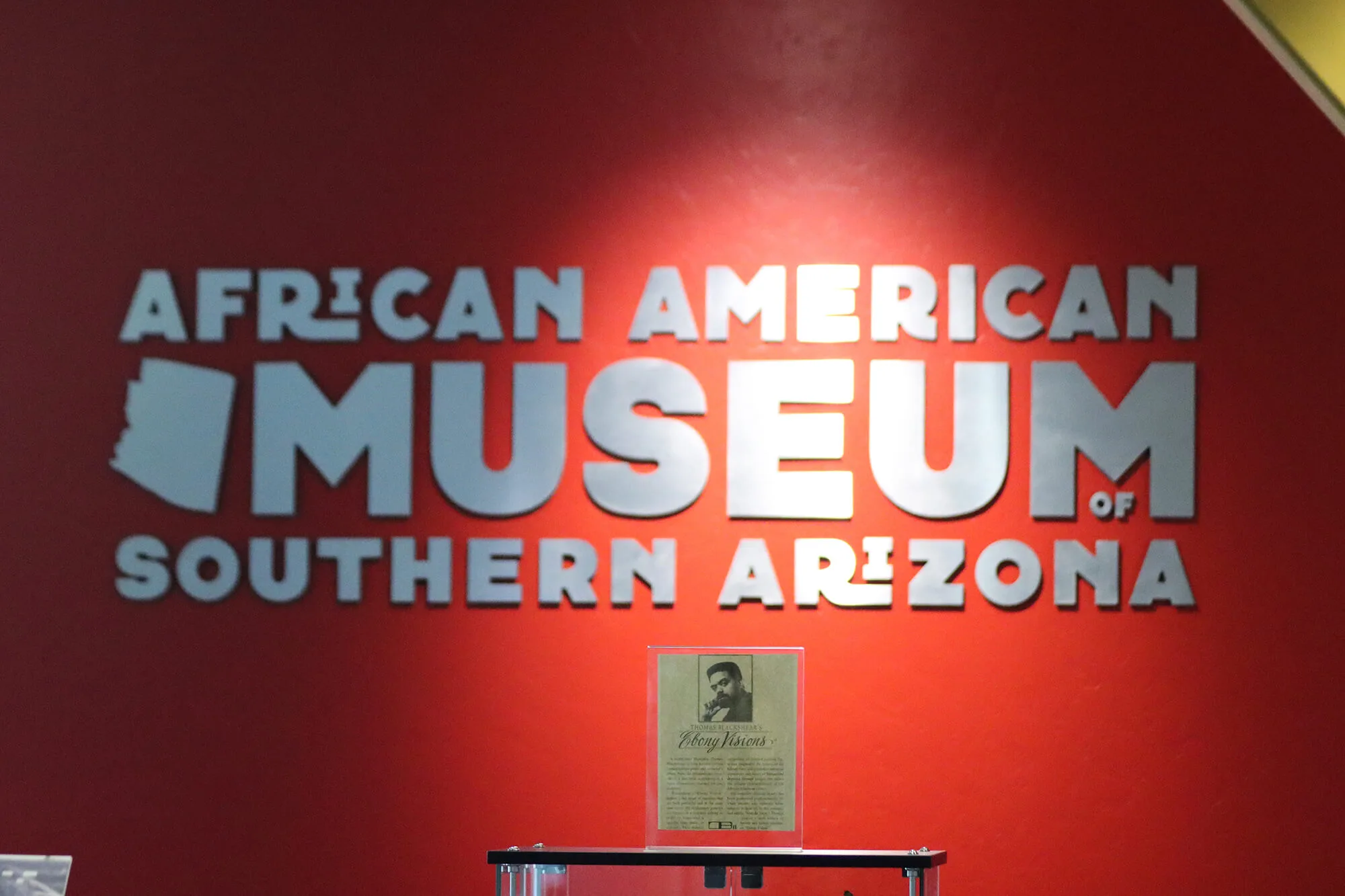
The African American Museum of Southern Arizona officially opened on Jan. 14, 2023, with the intention to “enable the community to join together and respect the past, honor the present, and pay reverence to the future while engaging and sustaining social action,” (Photo by Logan Camden/Cronkite News)
The museum is located on the campus of UArizona in Tucson.
A question posed by a 7-year-old doing a book report during Black History Month two years ago planted the seed for the creation of the African American Museum of Southern Arizona.
“So, where is the museum I can go to here in Tucson to learn about African American people who lived around here?” Jeremiah Elliott asked his grandmother, Beverely Elliott. She and her husband, Bob, went on to help found the recently opened museum.
After a little more than a year of work, the African American Museum of Southern Arizona officially opened on Jan. 14, 2023, with the intention to “enable the community to join together and respect the past, honor the present, and pay reverence to the future while engaging and sustaining social action,” according to the museum’s website.
RELATED: Desert Botanical Garden Nurtures Endangered Monarchs at Majestic Mariposas Exhibit
“We are a movement, not a museum,” Beverely Elliott said, noting some of the exhibits focus on current social justice movements like efforts to pass the CROWN Act, which would prohibit race-based hairstyle discrimination in schools and workplaces.
Elliott stressed that the museum is for everyone. “That’s not just the African American community, that’s the community at large in southern Arizona,” Elliott said. “Luckily, the University of Arizona was so accommodating.”
The museum is located on the campus of UArizona in Tucson.
“Most museums take between five and 20 years to really put a museum together,” Elliott said, but community interest helped AAMSAZ open in just 14 months. “The great thing about being on campus is we have amazing resources.”
“We have a lot of great and amazing stories. We want those stories to be told, and our community wants their stories and the stories of their families to be told. … They’ve had an impact and helped to build this community. And that’s really important,” Elliott said.
The museum currently features seven exhibits on display, but Elliott said they’ll rotate. “We want people to be able to come back in four months and say, ‘Oh there’s something new.’”
Elliott hopes people come away from the museum having learned something.
“As a former educator, I just want people to tell me, ‘I learned something when I was here.’”
Here’s a look at several of the exhibits at the museum:
Fred Snowden
The most prominent exhibit in the museum features former University of Arizona basketball head coach Fred “The Fox” Snowden. In 1972, Snowden was hired at UArizona, where he became one of the first African American head coaches in NCAA Division I basketball history. Snowden took over a Wildcats team with a 6-20 record from the previous season and led them to seven straight seasons with a winning record. Under the tutelage of Snowden, the Wildcats would reach the NCAA tournament three times and even reach the Elite Eight in 1976. Snowden amassed a record of 167-108 as head coach at UArizona, according to the Pima County Sports Hall of Fame, and helped mentor future NBA players, including Eric Money, Bob Elliott, Larry Demic and Leon Wood.
Underground Railroad Quilt Codes
Another exhibit at the museum is a quilt depicting codes used by enslaved people and members of the Underground Railroad. People of the Underground Railroad would create quilts with specific codes to guide enslaved people to safe locations and alert them to potential dangers. The quilts were hung outside on a fence or a windowsill seemingly to air or dry out.
Buffalo Soldiers
In 1866, Congress created six all-Black Army regiments of former enslaved people and Civil War veterans who became known as the Buffalo Soldiers. Despite battling harsh living conditions, racial prejudices and dangerous assignments, the Buffalo Soldiers battled in the Indian Wars and Spanish-American War and were instrumental in gaining statehood for New Mexico and Arizona.
The Buffalo Soldiers served for more than 80 years, until President Harry Truman in 1948 ordered the desegregation of all aspects of the military. Prominently on display at the AAMSAZ are works of art done by Don Stivers depicting Buffalo Soldiers in and around battles and clay sculptures of Buffalo Soldiers.
The CROWN Act
The CROWN Act and Love Your Hair exhibit features a current social justice movement focusing on traditional natural hairstyles worn by African American women. The CROWN Act–for Creating a Respectful and Open World for Natural hair–was first introduced in California in 2019 to prohibit discrimination based on race-based hairstyles, by extending statutory protection to hair texture and styles such as braids, locs, twists and knots in the workplace and public schools. The movement aims to gain traction nationwide. The exhibit features facts about hair-based discrimination in the workplace and a QR code that visitors can scan to sign their name in support of the CROWN Act.
Looking for the latest Arizona news? Sign up for our FREE daily newsletter.
Politics

6 terrifying things that could happen if the Comstock Act is used to target abortion
Does 1873 sound like a really, really long time ago? Well, that’s because it is—but if Republicans and far-right anti-abortion activists have their...

He said what? 10 things to know about RFK Jr.
The Kennedy family has long been considered “Democratic royalty.” But Robert F. Kennedy, Jr.—son of Robert F. Kennedy, who was assassinated while...
Local News

Opinion: Strategies for Child Abuse Prevention
11 ways you can be an ally in the fight against child abuse. April is Child Abuse Prevention Month. In the United States, it is estimated that a...

Biden marks Earth Day by announcing $7 billion in solar grants
The Biden administration on Monday announced the recipients of its Solar For All Program, a $7 billion climate program that aims to lower energy...




